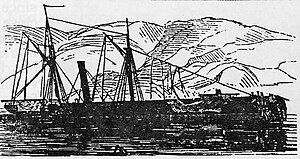SS Vesta was a propeller-driven fishing vessel 250 gross tons, built in 1853 at Nantes, France, by Hernoux et Cie of Dieppe for the Société Terreneuvienne of Granville in Normandy.[1] The company had extensive fishing interests in the Grand Banks area off Newfoundland, which it operated from a base in Saint Pierre Island.[3] On 27 September 1854 Vesta was eastbound with a crew of 50, returning 147 fisherman and salters home. In a heavy fog, Vesta collided with the Collins Line passenger paddle steamer SS Arctic.[4] A three-metre (ten-foot) section of Vesta's bow was sheared off, but the watertight bulkhead behind the bow remained intact and kept out the sea, keeping the vessel afloat.[1]
 Rudimentary sketch of the Vesta after the Disaster
| |
| History | |
|---|---|
| Name | SS Vesta |
| Owner | |
| Completed | 1853[1] |
| Name | Amberes |
| Owner | 1863–1875 J Amann[2] |
| Fate | Sunk in Santander harbour 1875[2] |
| General characteristics | |
| Tonnage | 250 GRT[1] |
| Length | 46 m (152 ft)[1] |
| Beam | 6.2 m (20 ft 4 in)[1] |
| Draught | 3.2 m (10 ft 5 in)[1] |
| Propulsion | Steam-powered[1] |
The much larger Arctic, which initially had appeared to have sustained only superficial damage, had been fatally holed below the waterline. Lacking watertight compartments, the hull filled with water and the ship sank, four hours later, with great loss of life.[5] By contrast, the only casualties from Vesta's crew and passengers were about a dozen who precipitately left the ship in a lifeboat, which was then accidentally run down by the Arctic.[6]
After the collision, Vesta's captain, Alphonse Duchesne, brought the ship slowly to St John's, Newfoundland, which she reached on 29 September, and was repaired.[7] On 20 March 1855 Vesta sailed for home, and was forced into Liverpool after fighting ice and storms for 17 days.[1] Later that year she was sold to the Compagnie Générale Maritime of Le Havre, and after further changes of ownership, passed in 1863 to J Amann of Bilbao and was renamed Amberes. She was used as a freighter, generally working between northern Spanish ports and Antwerp. In 1875, the shipping registers reported her as sunk in Santander harbour.[2]
See also
editNotes and references
edit- Citations
- Sources
- A.C. Brown: Women and Children Last. Frederick Muller, London 1962 [ISBN missing]
- William H Flayhart: Perils of the Atlantic: Steamship Disasters, 1850 to the Present. W.W. Norton, New York 2003 [ISBN missing]
- Lincoln P Paine: Ships of the World: An Historical Encyclopedia. Houghton Mifflin, Boston 1997 [ISBN missing]
- David W Shaw: The Sea Shall Embrace Them. The Free Press, New York 2002 [ISBN missing]